Last updated: April 7, 2025
Article
Podcast 100: UHawaii Hilo students caring for ‘ohana at Kalaupapa
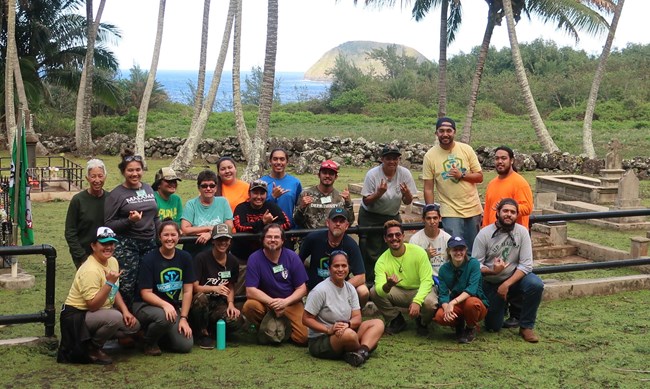
National Park Service
Introductions
J. Church: You’ve been here now for a week and a half doing cemetery work here at Kalaupapa, so introduce yourselves and let’s talk about what you’ve been doing.
Darienne: My name is Darienne Marie Kaiaʻokūlaniakea Kealoha, I go by Darienne.
Nanea: Aloha, my name is Naneaikealaula Victoria Thomas and I go by Nanea.
Cody: Aloha, ʻo Cody koʻu inoa my full name is Cody Koʻokāne Pacheco, but you can call me Cody.
Kinohi: Aloha ʻoe, my name is Kinohi Pūkaua o Kamehameha Neves and you can call me Kinohi.
Sheldon: Aloha, my name is Sheldon Takeshi Keoni-Kawikaonalani Rosa and you can call me Sheldon.
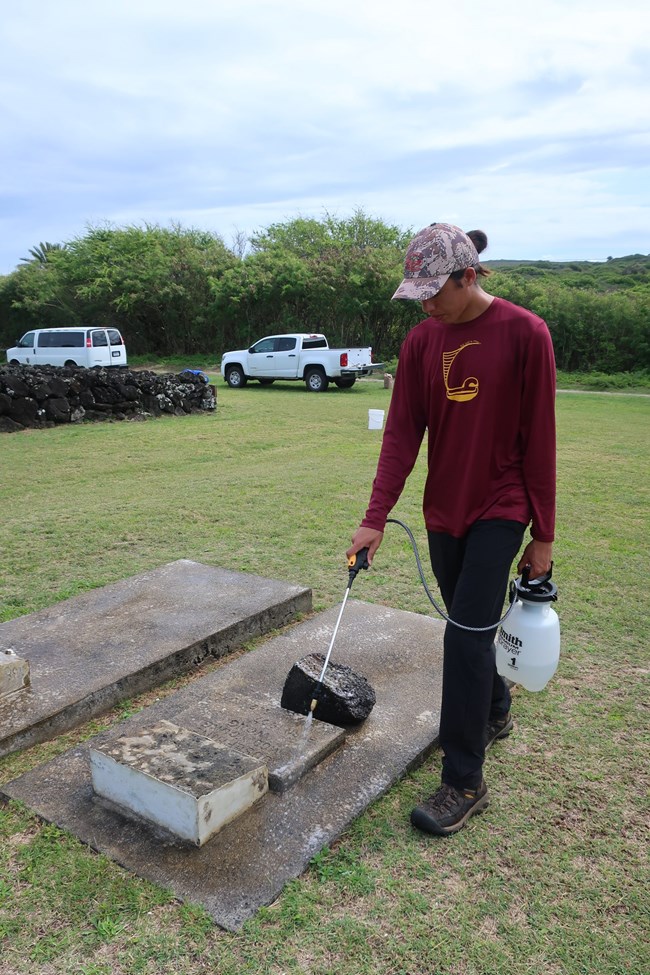
National Park Service
What interested you in volunteering?
J. Church: What interested you in doing this project? Why here and why the cemeteries?
Cody: Well first, before I think we talk about the importance of being here, we should talk a little bit about the history of this space and so where we are located right now is a peninsula on the island of Molokai and it’s called Kalaupapa. This peninsula at precontact time had Native Hawaiians living and residing here but in 1866, that’s when the first leprosy patients were brought to this settlement. There were nine of them, there were six men and three women. And at that point in history, Hawaii was experiencing a very drastic change in the way that our native populations dealt with leprosy and how our ancestors were dealing with that disease, which at the time, had not cure.
And so, this settlement which is about two by two miles long and wide, totally trapped off from the rest of our islands because of the two thousand foot pali or cliffs on one side and then being surrounded completely by the ocean on the other side. And so, you can think of it as a natural prison and so when our government was dealt with the leprosy epidemic that was occurring, the Board of Health decided to take these people from our communities who were dealing with leprosy and put them in this landlocked prison of some sort.
And so, that started in 1866 and since then…it ended in 1969 and in between 1866 and 1969, roughly eight thousand patients were brought to this peninsula and so the reason that we’re here is because that eight thousand plus patients that were buried here and died here have graves and markers. Not all of them but those that do have that, we’re here to just mālama take care of them.
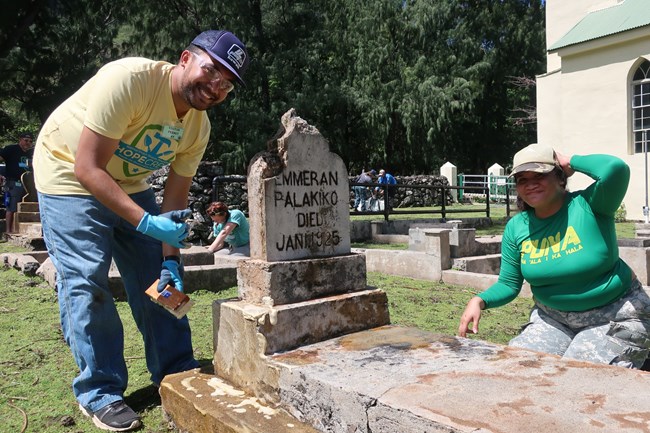
National Park Service
Connecting with family and personal history
Kinohi: Mahalo Cody, for all of his manaʻo it’s important to go to the history because when you hear the history, you’d assume that everyone would want to be here, but for a lot of schools and this was brought up during our week here, that sometimes this subject is not covered in our classes. I know in my education, it wasn’t really a subject in school. As he mentioned, there’s eight thousand patients and during our work days here, we’ve seen a lot of familiar names. Some family members that we didn’t know had family here and maybe they don’t even know our friends connection here.
For me, my parents have always told me that there was a family member that was a resident here. That drew me into being a part of the class, being involved and to reconnect that family tie.
Nanea: Like Cody and Kinohi said this place has a lot of very important history here in Kalaupapa for a lot of us students, it’s personal history. We are called here, not only a privilege but in great honor to be able to come to this space and mālama each and every single grave on this peninsula. A lot of us are called here because we do have family here, whether we are able to identify their tombstone or not, every single grave on the peninsula is ʻohana to each and everyone of us and it’s very special too when we do find our ʻohana because whether you see the name or you hear someone say the name out loud and you’re like that’s my ʻohana it’s bigger than an oha moment, it’s that connection that just…it roots you even more to this space and really makes you appreciate just being able to be here.
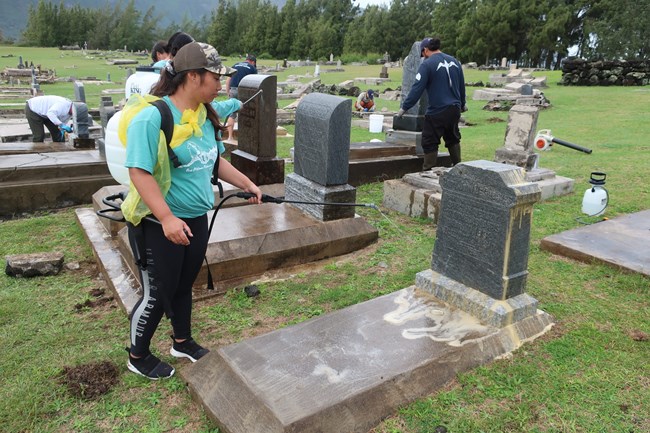
National Park Service
Tugging to connect at Kalaupapa
Darienne: To go off of what Nania was saying and then to go all the way back to Jason’s question about why we applied, it was something that Kumu Kai mentioned in one of her history classes. It was just that she was going to have this class and if you want to do it complete the application with an essay and when I did the essay, it was the first time that I really thought about whether or not I have a connection here, or how much my family doesn’t know about Kalaupapa. And when I started to ask my family members, they didn’t even know what island Kalaupapa was on or like what it really was. All they knew was, oh yeah, some Hawaiians got sent there and they were isolated from everyone else.
When Kumu Kai put it out there that we were going to come to Kalaupapa, it felt like a tugging sensation and it felt like something I had to apply for, and I had to make sure that I was going to come here, and I was going to be able to be on this trip. And like everyone has said, we all have connections, but we don’t always know about it.
Yes, so the more I learned about Kalaupapa, the more questions I asked my family and I found out that I did have family here and had I not got that tugging sensation to come to Kalaupapa, I wouldn’t have asked about our family history here or even if we had history here.
When we went to ʻĪliopiʻi it just so happens that my family was there that day. I didn’t think much of it when somebody told me, “Oh, I found a Kahihikolo over here, maybe check it out.” As soon as I got to the grave, I burst into tears. And I think everybody saw me just like crying on the side to myself. That was something that kind of brought it all together for me was that feeling of connection to my family and to my culture that I don’t really get to experience that often.
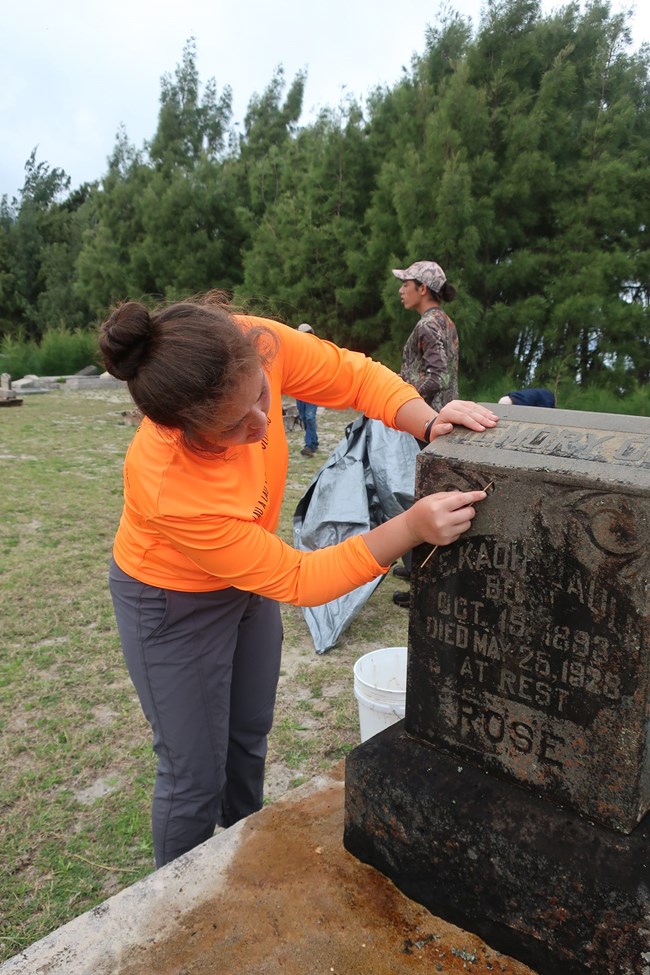
National Park Service
Remembering cultural history, keeping it alive, passing it on
Sheldon: That we can clean the gravestones and how we can mālama and take care of the kūpuna so that we can remember it, we can pass on their stories, because you know we all have a kuleana here. We all didn’t get to experience this teaching of what Kalaupapa is and what the trauma that these patients went through. So, we all have a responsibility here to teach this to our children and to the next generation to make sure that they know this history, because if you don’t pass it on, then it’s gone.
Cody: Today, Kumu Kai asked me a question in the field that we were working in, she said, “Cody, are you learning things from this workshop? What have you learned if anything?” And amongst the many things that I listed to her in response to that question was, that the ability and skills that I’ve gained in learning how to mālama and take care of these gravestones and the connections that are built when you take care of them, is something that I’m going to take home to my families graves.
And I know…when I was a kid, my family would always on Sundays go to a cemetery where a lot of my ʻohana is buried and it’s been awhile since we’ve gone but I know that a lot of the graves of my ʻohana is falling apart or the soil is running away and just being in this workshop, constantly I’m thinking about how now I have the tools and the skills and the desire more to go back home and take care of that ʻohana that I know deserve more. And so, I really appreciate that from this workshop.
Nanea: Like Cody said, how to properly tend to cemeteries, specifically gravestones and thinking about the gravestones that I can access and tend to back at home. When I was young, my mom used to take us to Kona of the island, which is where most of my family is buried and we were never allowed, me and my siblings were never allowed to eat McDonald’s and so when we’d visit the cemeteries, we’d buy one bag full of all cheeseburgers and we’d go eat our little McDonald’s at the cemetery. And I didn’t like pickles so I’d give pickles to the grave sites and then the fries that don’t make it into the little fries’ box, they would get dumped into the bottom of the bag, we’d dump it on the graves so they could enjoy it with us. And so now going home, I can do more than just give them my pickles, I can you know, properly scrub them, pull the weeds and tend to them, so I’m really excited and grateful to have learned all this knowledge on proper tombstone care and take that home to my ʻohana there.
When I think about it, there are over eight thousand patients buried here and only about one thousand, a little over one thousand of which are visibly marked graves. And so, when we research them and then see their graves, we get to, each person gets to mālama their person a little bit extra and then when they tell their story, it’s a way for us to do our…a small part in making sure that each person is remembered.
Kinohi: As Sheldon was talking about how he talked to Uncle Mike and that he describes this place as a forgotten place, I would say for whoever is listening that, that connection to us should be that where ever our grandparents, our uncles and aunties or whoever is buried, that that place doesn’t become a forgotten place as well. That we learn from Kalaupapa that where our family is buried doesn’t become Kalaupapa as well. That we stay connected just as we reconnected here in this place.
Asking for consent, signs of permission
Darienne: On the first day when Jason, Molly and Rusty was talking to us about what we’re going to be doing for our time here, I don’t remember who said it but somebody said to ask for consent before scrubbing the graves and when they said that, I thought it was funny because we all knew we were going to do that anyway. That we were going to ask for permission to be in that space with our kūpuna before we work in the first place. And then something else to mention is that Aunty Mikiʻala it took some time to explain to us the different signs of our saying, “Okay yeah, you guys can come in, it’s okay” and some of the ones that she talked about was hearing the manu or like the bird chirping, is it a happy chirping or is it like a warning chirping. If it’s a happy one, then obviously, yeah you can go ahead and if it’s a warning, then maybe we should go somewhere else or maybe we should work on something else or it can be like the change in temperature and the wind or a feeling that you get, knowing that it’s okay to go in or it’s not okay to go in.
Sheldon: I would like to say thank you whole crew and Jason, Rusty and Molly for coming down as well as NPS for allowing us in here. Thank you for hosting us and giving us this awesome opportunity to give back to our community and give back to Hawaiʻi to the patients that lived here. Giving us the opportunity to reconnect with these people and to connect back to Kalaupapa. We now all have a kuleana that we need to ʻauamo or carry, a responsibility we get to carry and we’re thankful that you opened that avenue and that gate for us to be able to explore this and to learn how to take care of our kūpuna. It’s been an awesome experience and it’s going to be a memory that I’m going to cherish for the rest of my life.
Kind of ending it on “He Mu” it’s a protocol we do before we leave so that all the negative energies, of spirits perhaps, you know they’ve never seen people in a longtime sometimes. So, when they see us young people coming down, they get excited and they want to talk. So, we do this just to tell them like, goodbye. Please stay where you are and don’t follow us back and just to keep them where they should be, because you don’t want to be taking this energy with you because it can affect your life. That’s what a lot of people have been saying to me before I came here, like don’t bring anything back. So, they gave me a bunch of salt, like make sure you leave Kalaupapa at Kalaupapa. But yeah, I’m just making sure we let them know like, okay we are leaving and a hui hou, never aloha but always a hui hou, until we meet again.
UH Hilo students: Chanting “He Mu”.
Read other Preservation Technology Podcast articles or learn more about the National Center for Preservation Technology and Training.
